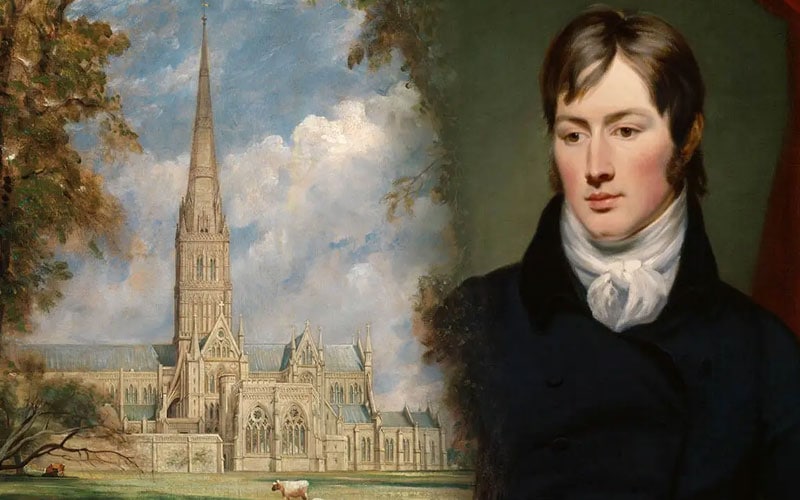
John Constable (1776 – 1837) is one of the most famous British landscape painters. Alongside Claude Lorrain, Constable is credited with being arguably the most influential artist of the entire genre, who completely changed the way landscapes would be viewed and painted after that.
Constable was an open critic of the idea of Idealism that was popular in art at the time. Idealism is the view of seeing things in a perfect or idealized way, similar to a fantasy. Instead, Constable adopted the approach of Realism when portraying the glory of the natural world.
Constable’s highly-realistic depictions were only achieved with great patience, painstaking observation, and the sheer love of nature. This love of nature, together with the attention to detail, flourishes throughout all of Constable’s paintings, and it is easy to see why Constable is considered one of the best.
Critics of Contemporary Art Movements
Elements of Style
Another aspect of John Constable’s painting that makes him stand out among his peers is the little details and personal touches of style. For example, Constable added more colorful hues and detailed lighting in his paintings compared to other artists of the time.
The more you study and learn about painter John Constable’s work, the more apparent these details are. The artist’s ability to convey complex aesthetics of nature, such as broken lighting and the movement of the wind on trees and clouds, for example, is unparalleled.
Clouds patterns were of a particular fascination for Constable. He spent hours upon hours studying their movements and forms and their effects on the light of the sun’s rays. As it cuts through the clouds and glistens on the water’s surface, this sun’s pure light would become a hallmark of Constable’s artwork.
Rejection of Contemporary Style
Of Constable’s artistic philosophies, a rejection of contemporary ideas stood at the forefront. Although having been trained in the classical style and ways of painting, Constable rejected these ideas in favor of following the path of nature.
In other words, Constable felt that human beings couldn’t possibly achieve anything more significant or more beautiful than nature itself, so the course of action for a painter was to attempt to capture the essence of nature as realistically as possible.
Constable wasn’t particularly successful during his lifetime like many great artists throughout history. Like Van Gogh or Claude Monet, for example, it took quite some time before mainstream beliefs would come around to the new ideas posed by Constable.
Realism Over Idealism
Constable’s fervent belief in Realism stemmed from a deep love and appreciation for nature going back to his childhood. However, this belief ran counter-intuitively to that of the Idealist and Romanticist movements that were taking place in the world of art at the time.
Romanticism emphasized several significant themes, such as inspiration, individualism, freedom, and the belief that the human imagination is superior to everything in the outside world. Idealism held a similar mindset in these regards also.
Constable rejected this viewpoint and aggressively took the opposite stance when constructing his artwork. Constable’s romance was one in cooperation with nature, not one in cooperation with his ego, which he felt most of the Idealists were doing.
Landscape Painting Revolutionary

Wooded Landscape – John Constable
With this humbleness and through the lenses of Realism, John Constable’s paintings have endured where so many of his contemporaries are now forgotten. As a result, Constable’s work elevated and revolutionized the entire landscape genre, which was considered a lesser one compared to others.
He achieved this in several ways. Firstly, he did away with traditional brushstroke techniques instead of experimental new ones. These included loose, expressive brushstrokes and palette knife techniques, which resulted in an enhanced sense of realism. Most importantly, though, he stuck by his intuition and artistic vision.
Constable’s artwork can even be seen as also influencing the Impressionism and Expressionism movements. Although these two movements moved away from Realism somewhat, their aim of capturing the feeling and emotion of the beauty of nature goes hand in hand with Constable’s ideals.
The Beauty of Truth
Above all, Constable wanted to paint the truth. He believed it to be a great vice of the artist’s ego to try and paint something beyond what is true. He felt that any artist who did so ultimately failed to produce anything of actual value compared to the perfect beauty of nature itself.
Instead, Constable wanted to represent what he saw as truthfully as possible, and his paintings and drawings of Constable can be seen as a reflection of this near-impossible endeavor. Constable aimed to express the multitude of feelings that nature can inspire and encapsulate within his paintings.
One could go so far as to mention that John Constable’s purpose was to encapsulate the very nature of truth itself. This is one task artists and philosophers have been trying to quantify for centuries now. Constable did as good a job as any human before him in his artistic representations and understanding.
Conclusion
When discussing the painter John Constable, his criticism and rejection of contemporary art must be mentioned. But instead, he followed his artistic intuition and produced some of the most outstanding landscape artwork ever seen. By this benchmark, Constable proved that his criticism was a worthy one. At the very least, he proved once again, without any doubt, that no great artist is ever contemporary.







